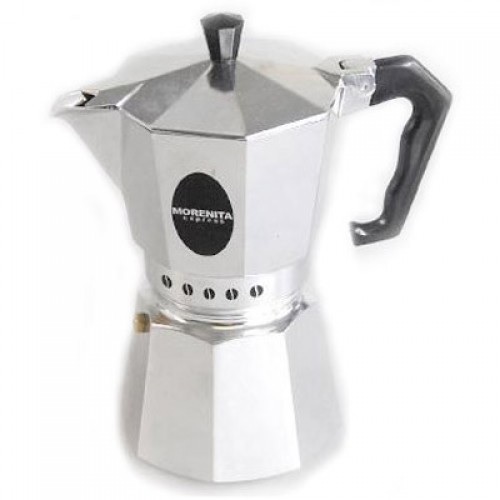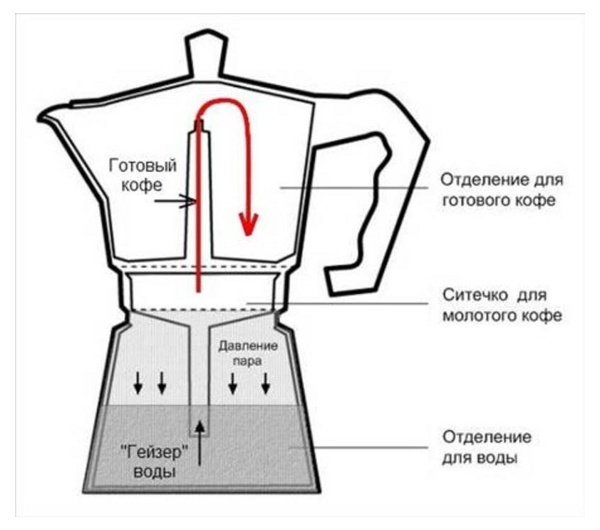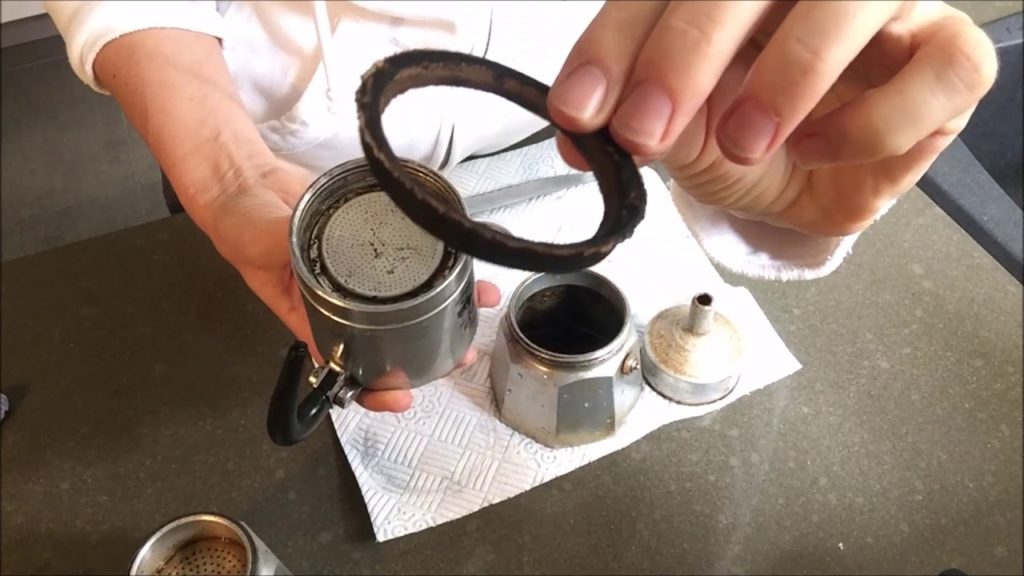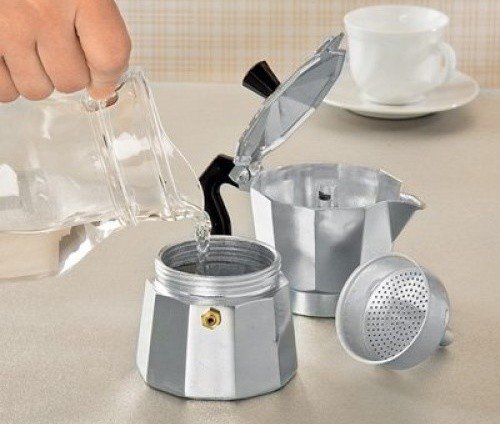Gas and electric coffee makers replaced the standard coffee pots, the use of which requires an open source of fire. The device "geyser" allows you to brew an invigorating drink in automatic mode without human intervention. Device modern geyser coffee makers allows them to turn off on their own after making coffee.
Geyser type devices are quite practical, they are easy to use. Many coffee makers are equipped with various additional functions and are able to prepare cappuccino, espresso, latte and other types of drink.

What is a modern geyser coffee maker
The first copies of such coffee makers appeared in the XIX century. Initially, the apparatus included two vessels for water and coffee beans, interconnected. The design was further improved: a third department for the prepared drink was added. The Italian geyser coffee machine has established itself exclusively on the positive side due to the taste of the produced drink.

Modern "geyser" for making coffee
The design of the geyser coffee machine is reminiscent of a standard kettle; its principle of operation is to prepare a drink using water vapor. The compactness of the device and its low cost are the main advantages of the geyser, and washing the filter elements of the coffee maker after preparing the drink is a drawback of the device.
Types of Geyser Coffee Makers
Among these modern devices, two main varieties can be distinguished:
- Electric coffee maker - for its functioning requires an AC network.

Electric Geyser Coffee Maker
- Gas type coffee maker - for its use, a gas burner or other open flame source is required (operation on an induction stove is also allowed).

The second type of product is perfect for making coffee at outdoor events (fishing, camping, picnic, going out, etc.).
A networked device will prepare a drink much faster than a gas counterpart, but its use is limited to rooms (home, office) equipped with electrical outlets.
Component parts of the device
The case of geyser coffee makers was originally made from aluminum alloys, but modern technologies make it possible to make coffee pots from ceramics and steel alloys that are protected from corrosion.

Coffee machine design
How does a domestic geyser coffee machine work?
The device consists of the following main components and parts:
- the lower (most voluminous) capacity in which water is poured and where it is subsequently brought to a boil;
- the upper container, designed for the finished coffee drink (it is in this part of the device that the main process of making coffee under the influence of rising water vapor occurs);
- there is a special funnel-shaped filtering device between the containers (designed to clean ground coffee beans);
- another additional filter located in the bottom of a special tube connecting both containers (when boiling liquid, steam squeezes part of it into the upper container through this device, which results in brewing a coffee drink).
All filter elements of coffee devices are the most vulnerable parts. They require cleaning after each brewing, as well as periodic replacement with new parts. A dirty valve can cause the unit to explode.

Dismantling the apparatus for further cleaning and checking filters
Geysers made of aluminum can cause a slight metallic taste in the drink. Such devices are not recommended to be completely cleaned of the remains of coffee oils that settle on the inner walls of the device and prevent this unpleasant moment.
The principle of operation of a standard geyser type coffee maker
When certain temperature indicators are reached, the water goes into a vapor state, which is the main condition for making coffee. Steam actively rises to the top and periodically breaks out from under the cover of the device, resembling a real natural geyser.
A coffee drink prepared in this way differs in its taste from analogs prepared in a standard way using conventional boiling water, and has a more saturated taste and aroma.
How to brew coffee in a geyser-type coffee maker
Each electric and gas coffee maker has an instruction manual, having carefully studied which, you can safely operate the device. The overall picture of making coffee in various “geysers” will have similar features.
How to use a home geyser coffee maker
To make coffee at home or in the office, you will need to do the following manipulations with the machine:
- the coffee maker must be completely disassembled for further filling with consumables;
- the lower tank should be filled with cold water to the specified level, but not above the valve;
- ground coffee beans are poured into the upper part of the apparatus in the amount prescribed in the instrument's operating instructions (the use of medium-ground coffee beans will be optimal);
- then you should connect both parts of the device and connect the coffee maker to the network or put on the stove;
- After boiling coffee (if there is no automatic device shutdown device), the device must be removed from the stove or disconnected from the outlet.
Long boiling the drink greatly reduces its taste.
Tips for improving the quality of coffee
To prepare a drink with maximum taste and alluring aroma, you can use the following list of tips from a professional barista:
- coffee beans should be grinded immediately before the preparation of the drink to preserve the taste and aroma of whole beans (the average or large size of the coffee beans at the exit will be the best grinding);

Coffee grinder sizes
- water for making coffee should not have impurities, therefore it is recommended to use distilled (spring) or purchased bottled water;
- the device itself must be cleaned after each preparation of the drink in order to avoid mixing the taste of different types of coffee in the future (the use of chemical detergents and reagents is strictly not allowed);
- coffee beans should be compressed as much as possible in the upper container of the device (the condition for unhindered passage of water through the filter through the pipe from the lower container to the upper one must be observed to avoid the occurrence of an explosive situation);
- it is better to preheat the dishes for the finished coffee, so the drink will retain its maximum taste;
- for safety purposes and to preserve the taste of the drink, the coffee maker should not be opened during operation;
- the strength of an invigorating drink depends on the size of the grains (the smaller the grinding, the stronger and thicker the drink will be);
- a new coffee machine should be “run in” (the first few servings of the prepared drink should simply be poured).

Coffee beans
Coffee Maker Care Tips
To increase the service life of the device and improve the quality of the drink, you should follow all the tips and requirements for using a geyser coffee maker, according to its operating instructions.
Additional useful tips for caring for your device:
- after each operation of the “geyser”, all internal surfaces of the device should be thoroughly washed and cleaned (this condition is not suitable for coffee makers with a steel case. In such devices, coffee oils protect future prepared beverages from the presence of a metallic taste);
- the device is better to clean after cooling;
- the most important point is to maintain the filter elements and gasket of the coffee maker in good condition (this will save the taste of the drink, as well as avoid a fire hazard caused by clogging of the corresponding channels and holes);
- it is better to clean the coffee maker with specialized detergents (the use of dishwashing chemicals is strictly not allowed);
- periodically it is necessary to check all the functions of the device to exclude their possible malfunctions;
- electrical appliances should be careful about the nodes in the electric circuit (strong bending of the wires and violation of the nodes of their junction with the device is not allowed).
Geyser coffee machine: what is it and what is dangerous
This apparatus is a source of danger, as it can provoke an explosion or electric shock. In case of breakdown or errors in the work, it is better to seek the help of qualified specialists.
Large manufacturers of geyser devices value their reputation, so they usually do not refuse quality repairs and maintenance of their own products.
The influence of coffee maker material on the taste of coffee
The final taste of your favorite drink is influenced by many factors, depending on the size of coffee beans, water quality, method of preparation and many other aspects.

Pouring water into the apparatus
Modern geyser coffee makers are made from ceramics and various stainless steel alloys. It is worth noting that there are also aluminum devices on the market, which are the progenitors of the entire line of these products.
The presence in the structure of the apparatus of various impurities and metals can cause the appearance of small unpleasant shades of taste in the finished invigorating drink, therefore, such devices are recommended not to be cleaned to the ideal state. Also, the first few servings are better to just pour.
For several applications, a protective film of coffee oil is formed on the walls of the device, which will protect future portions of the drink from the penetration of unpleasant taste shades into it.
Conclusion
The characteristics of domestic geyser coffee makers allow you to prepare a drink in a few minutes. Coffee made in this way has excellent taste and alluring aroma.
The main advantage of the “geyser” is its simplicity, which is especially appreciated in modern life. To make a drink you will need water and ground coffee. Modern devices can also prepare cappuccino, glissa or hot chocolate. The amount of the finished product will directly depend on the volume of the coffee machine itself and its capacity.




